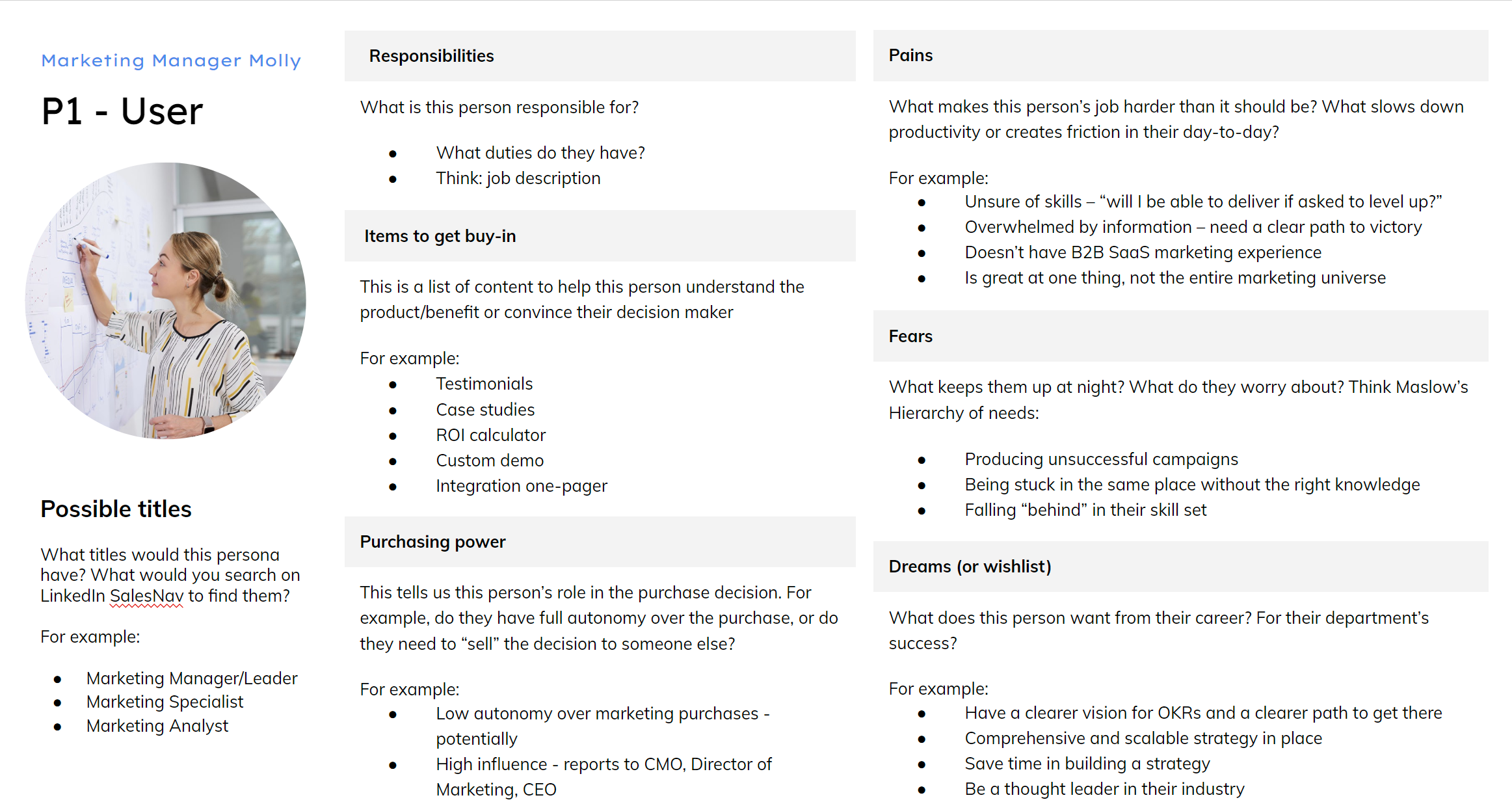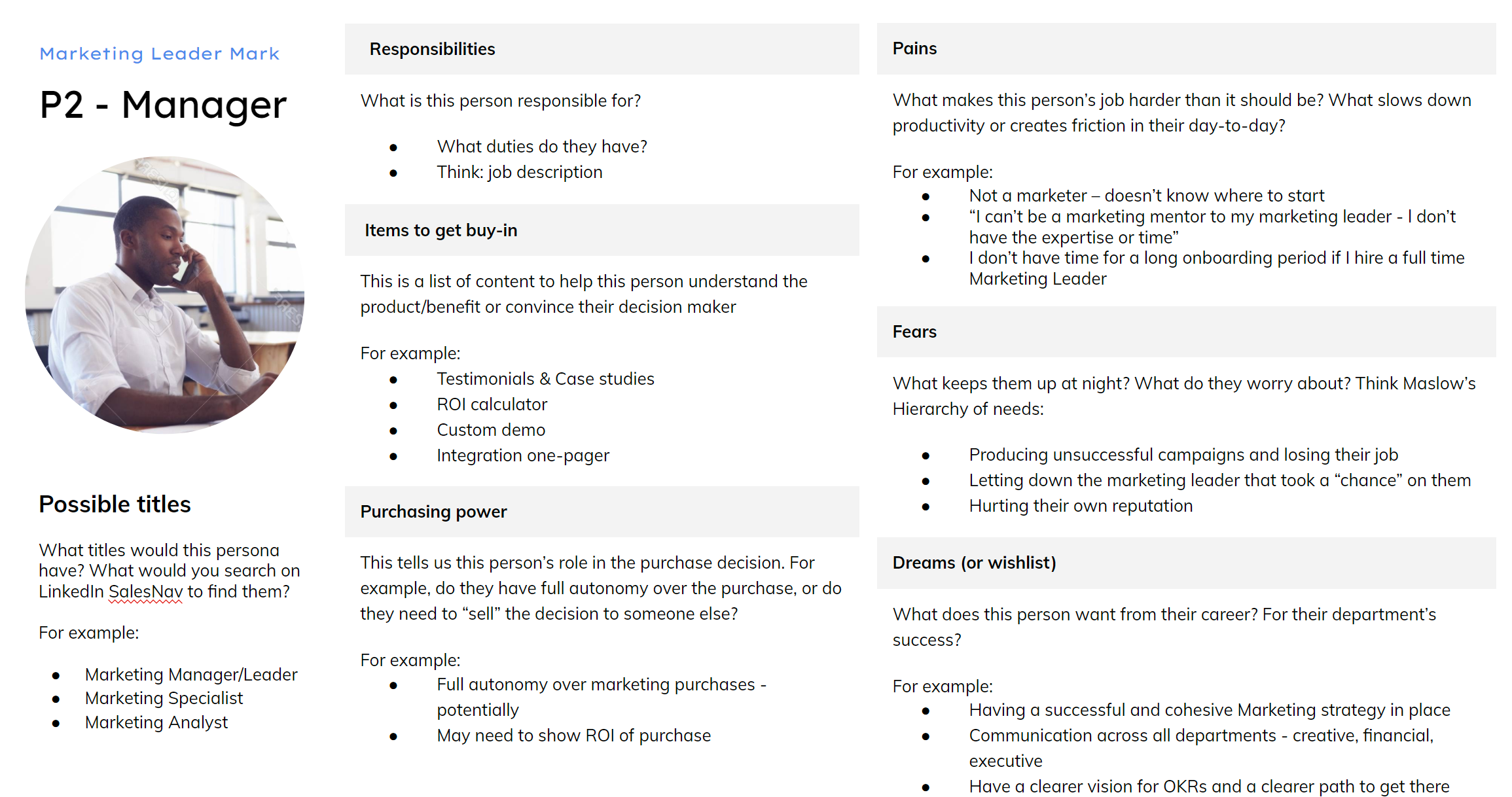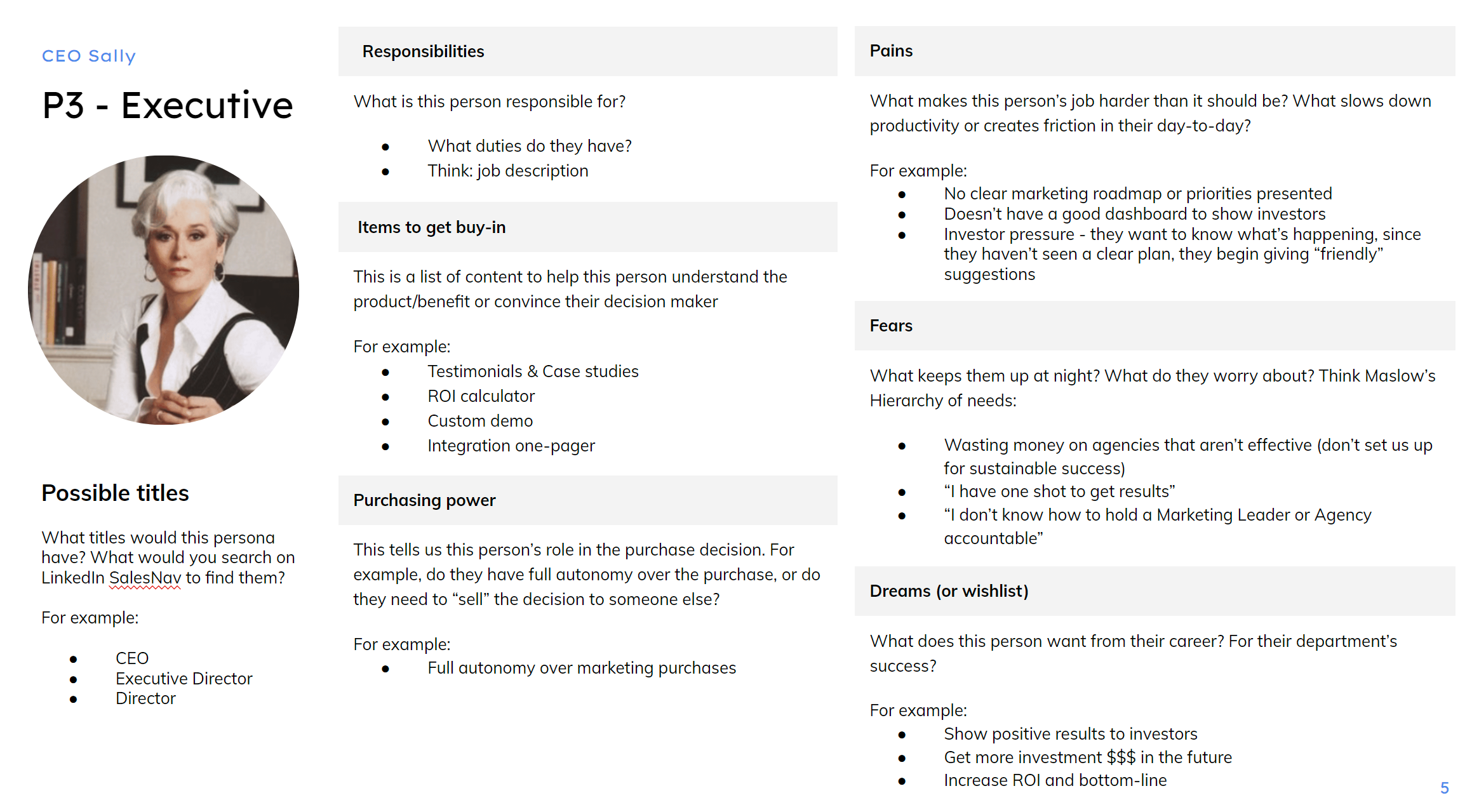In our work with B2B SaaS companies and their marketing plans, we have found that for any campaign, whether it's Account-Based Marketing (ABM), Inbound Marketing or Content Marketing, and even a Product Launch, you only need 3 buyer personas in your ideal customer profile to have success.
Why only three buyer personas in your B2B SaaS ABM campaigns?
More personas just lead to confusion, complexity, and unnecessary extra work. All you need to do is define three fundamental, foundational personas:
- Persona 1: The User
- Persona 2: The Supervisor
- Persona 3: The Executive
Persona 1 (P1) - The user
P1 is the user of the solution. She’s the primary beneficiary of using your software or service.
This persona is the day-in and day-out functional user who will operate and interact with the solution often, and typically has the most practical experience with how the solutions add value.

In addition to targeting this persona to drive awareness, consideration, and conversion, this persona is also a great source for message testing, and getting more insights about the value proposition we offer.
P1 is the "Advocate" in the Buyer's Journey
Our marketing goal is to make Persona 1 an advocate for buying our solution (or remove them as a potential blocker). This is what we need them to “believe”:
- Can make their job easier (make them more productive, make it more fun).
- Help them grow (learn something new, get challenged, level up).
- Be seen as an expert (become the “hero” in their role, a positive change agent, a leader).
- Prevent them from being a blocker due to feeling threatened by the solution we offer. Our solution will not “replace” them.
- Make them feel they become part of a group they like to belong to (users of the newest technology, innovators in their field, employees who drive savings or innovation for the company).
You may notice that a lot of this messaging is grounded in finding the “fears and dreams” of this persona and using the “Maslow Pyramid” to speak to what they care about.
Why do we start with Persona 1?
- Persona 1 (P1) is the “Gateway” to Persona 2 (P2). As we learn what P1 cares about, we can use that to create optimal messaging for our marketing to P2.
- Since P1 is usually an influencer, and not the buyer/decision-maker, P1 is also a relatively “low risk” test subject for message testing and marketing research.
- In our ABM Campaigns and Content Marketing, we like to start with targeting P1 so that we have optimized messaging and content assets before we go after the higher value P2 prospects.
- As a final bonus, our P1 messaging also allows us to ask referrals/introductions to the right P2 decision-makers, and help complete our high-quality ABM lists.
- P2 will need to make P1 “happy” with the solution that gets chosen. They like to understand what P1 needs, and how they can balance satisfying those needs and organizational priorities. Sometimes P2 used to be a P1, and we can use the same messages. Often though, we can help “educate” P2 with what we learned from P1.
- As the supervisor, P2 is the “responsible” filter to make sure the organization does not buy things that are not needed or are too expensive. ROI is key for P2. At Kalungi, we like to create ROI calculators, RFP templates and Buyer's Guides as content to engage P2.
- While P2 is usually the buyer/decision-maker, they still have to convince other stakeholders (P3). The executives they report to will care about ROI, Risk mitigation, alignment with company strategy, policies and standards, and making sure the decision fits with the most critical use of company time and resources.
- P2 can not only tell us who the other buyer's journey influencers are, but they can also tell us what they care most about. P2 is a relatively “low risk” test subject for message testing and marketing research that we want to use with P3 Executives in the next stage of our ABM.
- In our ABM Campaigns and Content Marketing, we like to focus our “lead magnets” to drive consideration and conversion on Persona 2 as the key decision-maker.
- As a final bonus, our P2 messaging allows us to ask referrals/introductions to the right P3 influencers, and help complete our high-quality ABM lists.
Marketing to Persona 1
We consider Persona 1 the most critical of these three for Content Marketing since we find that these people are usually looking for solutions to alleviate “pain”, address challenges in their job, or try to find ways to innovate how they add value for their employers.
Persona 2 (P2) - The supervisor
Persona 2 (P2) is the manager, supervisor or group leader of Persona 1 (the User). P2 oversees the function or team that benefits most from the solution we offer. They are usually the main decision-maker.

Account-Based Marketing Persona Cadence
For our account-based marketing, P2 is the most important audience. We start our ABM with P1, so we learn as much as possible about the validity of our messaging before we go after P2. In addition, P1 will help us find the right P2 person or their contact details like their email address.
B2B Marketing and SaaS Buyer Personas
The modern B2B Buyer's Journey usually involves multiple decision-makers. The main thing that differentiates B2B Marketing from B2C Marketing is that you are convincing someone to spend someone else’s money. Thus, in B2B Sales and Marketing, P2 is the person who we need to convince to become our sponsor.
Persona 2 will have to "sell" the rest of the organization on our solution, and convince them to free up a budget, pass IT or legal requirements and complete the procurement process. They will need to convince their own team who will become users, but also their management, who will influence the budget and other stakeholders such as Legal or IT.
What does Persona 2 care most about?
In addition to all the “fears and dreams” that apply to Persona 1, Persona 2 has additional specific needs, wants and desires.
As we learn what P2 cares about, we can use that to create optimal messaging for our Marketing to P3.
Persona 3 (P3) - The executive
P3 is the executive sponsor for P2 and cares primarily about ROI. Specific functional areas who can become “blockers” for procuring our solution are also included in Persona 3.
Examples are the legal department, IT or finance, with procurement guidelines, compliance requirements or privacy concerns, as examples of potential blockers.

Equipping an active “Advocate” for Persona 3
While Persona 3 does not need to play an early role in the buyer’s journey of P2, they often are brought in at some point, and ideally, we have equipped P2 with the right material to "sell" P3.
This SaaS buyer persona typically has the least amount of technical knowledge and they’re interested in learning more, but don’t know what to think yet. They’re looking for a practical foundation of knowledge to understand the context and intent of the solution, so they can fulfill their fiduciary, executive or sponsor responsibilities for the organization.
Here's the Personas template to get you started.
How to write impactful messaging for the three personas
Now, let's talk about messaging to these different SaaS buyer personas. When putting together a messaging framework, you need to answer three questions:
- Why should someone change? Why should they click or engage?
- Why should they engage (or change) with you? What makes you someone they want to follow?
- Why should they do something now vs. postponing their action till tomorrow or when the pain is big enough?
In the video below, Mike shares the framework we use at Kalungi to write compelling product messaging for each of these three personas.
Why change?
Step 1, why they should change, is about their "Pain". Sometimes, we call these “fears and dreams.”
A useful framework for thinking of this is to use Maslow's “Hierarchy of Needs” Pyramid to identify things they personally care about. In short, we want to make messaging personalized, talking about their interests and using the right name, etc.
Examples are things like:
- How can they become more productive?
- How can we make their job easier?
- Can they learn something new? Can they grow personally or professionally?
- What would give them a sense of accomplishment? How could they be seen as the hero or change agent? Conversely, maybe they are afraid to rock the boat?
- Do they want to be part of a certain group, e.g. like a Marketer who wants to be known for being a Digital Marketer?
- Safety, either physical or financial, is another great example, especially when the solution makes it easier to make their work safer.
Many of these examples apply to Persona 1, the user of the value proposition you offer. For Persona 2 it might be more about making a safe investment decision, being seen by their team as the hero who brings in the right tools and advocates for their needs. A P2 Supervisor needs to look good in front of their bosses, and of course, wants his/her team’s approval.
P3 often has pain related to ROI, meeting company security standards, risk mitigation and making sure the P2 who works for them is seen as a great contributor to the company’s strategic goals. They don’t have a lot of technical knowledge about the solution, but they still need to understand how their investment decisions will impact the overarching organization and the company.
These are all examples of the first part of messaging, "pain, fears, and dreams," to be communicated to each of these three SaaS buyer personas.
Why you?
So why should they follow you? After they've decided they have enough pain to click, engage or join, why should that be with you?
This is the "Claim" part of your Value Prop. It should always be communicated with the benefits (not features) of your solution, and you should sound/look like them. Remember, you want them to trust you as their guide. Try to use the words they would use while establishing credibility by demonstrating your superpowers and sharing how you can "take them to the promised land."
By appealing to your personas with the right positioning and messaging, they should trust you and confide in you as a valuable partner.
Why now?
Why should they not postpone the decision till tomorrow or until they have the budget? What will give them confidence that they will convince their boss?
This is about communicating what they stand to "Gain" and providing a compelling Call-To-Action (CTA). Ideally, you use stories or examples of people or customers who've gone before them. Share data and tangible results. Show (Photos, Videos) vs. tell, and help them envision themselves in that future state. Create a "Fear Of Missing Out" effect if they don't act. Remember, you're now the guide to "take them to the promised land" and it's key that they feel very excited about their destination.
To recap, here’s who to focus the various parts of your marketing strategy on:
- Persona 1: Content Marketing - Education “How” Content. PR/AR. Initial ABM Outreach.
- Persona 2: Email Marketing, Consideration & Conversion Content, Webinars, Sales Materials. Phase 2 ABM Outreach. Marketplaces, Online Reviews, Analysts.
- Persona 3: Thought Leadership Content, Analyst Relations, Phase 3 ABM Outreach.